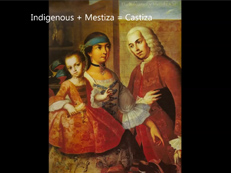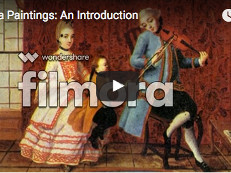I had learned a little about casta paintings in a cultural anthropology course a few semesters ago. Arguably, race is a constructed concept, and in colonial Latin America, it seems race was constructed to favour and ensure Spanish supremacy in the area. Interestingly, I think this relates to the general idea of Latin America; it […]
Posted in Blogs, Week 3 | Tagged with casta paintings, Catalina de Erauso, colonialism
Summary of Mey-Yen Moriuchi’s; The Art of Conversation: Eighteenth-Century Mexican Casta Paintings
My source for our group presentation is based off Week 3 topic of Colonial Latin America focusing on the hierarchical system of race and classification during the eighteenth century. These hierarchical systems were portrayed in forms of vivid illustrations called “casta paintings”. The article by Moriuchi explores and examines the art form and the ways that had been used represent Spanish, Black and the Indian population of Latin America at the time. It also gives an interesting view on the other side of the world when it compares these paintings to what had been going on in eighteenth century England, much like the casta paintings, English conversation pictures had been used to express social beliefs about the place of an individual in a society. In this summary, I explore the main abstractions and ideas discussed in the article with regard to the casta paintings.
Moriuchi begins by explaining the term ““conversation,” (Moriuchi, 8)
She then introduces the colloquial terms like the “Spaniard, Indian, Mestizo, Black, Mulatto, Lobo, Chino and Albino”- these had all been terms used to identify people of mixed races that lived during the colonial period in New Spain eighteenth century. The series of casta paintings consists of twelve to sixteen images on a canvas each having a man, woman and a child. The first few canvas show Spaniard and Indian mixes and there after the next few canvases illustrate Spaniard and African mixes Africans and Indians were regarded as the least elite having the lowest position in the society and therefore occupied the lower canvases.
The kind of clothing worn by people in the canvas is also examined by Moriuchi who explains how the privileged mixes would be depicted wearing silk or cotton often holding cigars or eating fruits and vegetables in their gardens or parlors whereas the Africans and non-converted or “heathen” Indians would be depicted naked, lying on the floors of corridors and holding weapons like bows and arrows. She explains how this proliferation of race and hierarchy caused the privileged to defend whiteness because of how lavish they were pictured in these casta paintings.
Moriuchi emphasizes that casta paintings are in a way humankind’s way of “perpetuating one’s memory and preserving one’s effigy” for generations (Moriuchi, 14) in a way she is implying that artists of this century did such art as a way to understand the racial mixes these were seen as conversations both internally and externally to the world to show what had been going on at the time.
Reading this article made me realize a lot of things, Casta paintings had been “used as a means of communication” they were merely portraits of what artists saw in everyday life, I feel as though the images were taken out of context and were seen as permanent hierarchies when in fact they were only just observations and forms of art. To this day the paintings continue to evoke controversial perspectives about race and hierarchy.
Moriuchi, Mey-Yen . “The Art of Conversation: Eighteenth-Century Mexican Casta Painting.” Graduate Journal of Visual and Material Culture Issue, vol. 5, 2012, pp. 1–25.
derived from the Latin word conversation- described as a means of expressing social and familial propriety represented the family’s wealth and social status.
Posted in Blogs | Tagged with casta paintings
Summary of Mey-Yen Moriuchi’s; The Art of Conversation: Eighteenth-Century Mexican Casta Paintings
My source for our group presentation is based off Week 3 topic of Colonial Latin America focusing on the hierarchical system of race and classification during the eighteenth century. These hierarchical systems were portrayed in forms of vivid illustrations called “casta paintings”. The article by Moriuchi explores and examines the art form and the ways that had been used represent Spanish, Black and the Indian population of Latin America at the time. It also gives an interesting view on the other side of the world when it compares these paintings to what had been going on in eighteenth century England, much like the casta paintings, English conversation pictures had been used to express social beliefs about the place of an individual in a society. In this summary, I explore the main abstractions and ideas discussed in the article with regard to the casta paintings.
Moriuchi begins by explaining the term ““conversation,” [1] (Moriuchi, 8)
She then introduces the colloquial terms like the “Spaniard, Indian, Mestizo, Black, Mulatto, Lobo, Chino and Albino”- these had all been terms used to identify people of mixed races that lived during the colonial period in New Spain eighteenth century. The series of casta paintings consists of twelve to sixteen images on a canvas each having a man, woman and a child. The first few canvas show Spaniard and Indian mixes and there after the next few canvases illustrate Spaniard and African mixes Africans and Indians were regarded as the least elite having the lowest position in the society and therefore occupied the lower canvases.
The kind of clothing worn by people in the canvas is also examined by Moriuchi who explains how the privileged mixes would be depicted wearing silk or cotton often holding cigars or eating fruits and vegetables in their gardens or parlors whereas the Africans and non-converted or “heathen” Indians would be depicted naked, lying on the floors of corridors and holding weapons like bows and arrows. She explains how this proliferation of race and hierarchy caused the privileged to defend whiteness because of how lavish they were pictured in these casta paintings.
Moriuchi emphasizes that casta paintings are in a way humankind’s way of “perpetuating one’s memory and preserving one’s effigy” for generations (Moriuchi, 14) in a way she is implying that artists of this century did such art as a way to understand the racial mixes these were seen as conversations both internally and externally to the world to show what had been going on at the time.
Reading this article made me realize a lot of things, Casta paintings had been “used as a means of communication” they were merely portraits of what artists saw in everyday life, I feel as though the images were taken out of context and were seen as permanent hierarchies when in fact they were only just observations and forms of art. To this day the paintings continue to evoke controversial perspectives about race and hierarchy.
Moriuchi, Mey-Yen . “The Art of Conversation: Eighteenth-Century Mexican Casta Painting.” Graduate Journal of Visual and Material Culture Issue, vol. 5, 2012, pp. 1–25.
[1] derived from the Latin word conversation- described as a means of expressing social and familial propriety represented the family’s wealth and social status.
Posted in Blogs | Tagged with casta paintings
I found “the Lieutenant Nun”, the excerpt from the memoir of la Monja Alferez, very fascinating. Which, of course, wasn’t the case until I read a summary of the memoir under her portrait. She must have had extraordinary battle skills to survive being a traveling soldier, murderer, and conquistador (to name a few), considering she was a woman; … Continue reading Week 3
Posted in Blogs, Week 3 | Tagged with casta paintings, The Lieutenant Nun
What became of the America’s after colonization was a complex process of cultural diversification. It is interesting to see how after 1942, the continent of America (both North and South) became diversified in terms of the different races and peoples that began to settle in the Americas. The Casta Paintings are a very clear example […]
Posted in Blogs, Week 3 | Tagged with casta paintings, colonial experience, indigenous, mestizo, population
I will be honest – Before LAST100, I had never heard of Casta Paintings before. However, after watching the lecture video, reading “Casta Paintings” by Susan Deans-Smith, and taking a closer look at these paintings, I have learned a fair bit. Casta paintings depict the different mixes in Latin America, starting with 3 different ‘purebreds’ …
Continue reading “Week 3: The Colonial Experience”
Posted in Blogs, Week 3 | Tagged with casta paintings, social heirarchy
So this week was focused on the Casta Paintings or grouping of people based on race. It was used for social control and often dictated someones role in the social system. Some defining characteristics depicted in the paintings were the clothes the people were wearing. Generally the “purer” European descendant wore the most elaborate and expensive clothing. So Spain during this time of colonization and expansions of the new world seemed to be having a sort of identity crisis in the homeland. They wanted to create a more uniform land….read more
Posted in Blogs, Week 3 | Tagged with casta paintings, race



